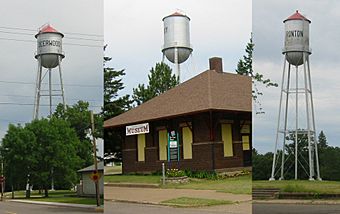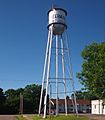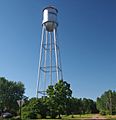Cuyuna Iron Range Municipally-Owned Elevated Metal Water Tanks facts for kids
Quick facts for kids |
|
|
Cuyuna Iron Range Municipally-Owned Elevated Metal Water Tanks
|
|

The water tanks in Deerwood, Crosby, and Ironton respectively.
|
|
| Location | Crosby, Minnesota Cuyuna, Minnesota Deerwood, Minnesota Ironton, Minnesota Trommald, Minnesota |
|---|---|
| Area | Cuyuna Range |
| Built | 1912-1918 |
| Architect | Des Moines Bridge & Iron Co.; Minneapolis Steel Machinery Co. |
| MPS | Cuyuna Iron Range Municipally-Owned Elevated Metal Water Tanks TR |
| NRHP reference No. | 80002027 |
| Added to NRHP | October 22, 1980 |
The Cuyuna Iron Range Municipally-Owned Elevated Metal Water Tanks are five old water towers located in the Cuyuna Range area of Crow Wing County, Minnesota. These tall metal structures were built between 1912 and 1918. They are important because they show how towns in the Cuyuna Range grew and planned their public services, like water systems, a long time ago.
These water tanks were added to the National Register of Historic Places in 1980. This means they are recognized as important historical sites in the United States. Their construction was possible because of special property tax money from the iron mines. This money brought a lot of income to the towns of Crosby, Cuyuna, Deerwood, Ironton, and Trommald.
Contents
What Are These Historic Water Towers?
These water tanks are large, elevated metal structures. They were built to hold water high above the ground. This height creates pressure, which helps deliver water to homes and businesses in the towns. They were a big step forward for these communities, providing clean and reliable water.
The companies that built these tanks were Des Moines Bridge & Iron Co. and Minneapolis Steel Machinery Co. They were important engineering projects for their time.
Why Were They Built? The Mining Boom
The towns in the Cuyuna Range started to grow around 1910. This was when iron mining began in the area. Iron mining was a huge industry back then. It brought many jobs and people to these small towns.
The peak of mining jobs was around 1920. This meant more people needed places to live and public services. The towns used the money from mining taxes to build schools, parks, and good streets. They also built complete water systems, including these large water towers. Even smaller towns could afford these big projects.
Life in the Mining Towns
A historian named Theodore C. Blegen wrote about how special these mining towns were. He said they had amazing schools, community buildings, and parks. These were much better than what most other cities in Minnesota had at the time. This showed that the people wanted the best for their communities and their children. They also had enough tax money to pay for everything they needed.
After the 1930s, iron mining started to slow down. By the 1950s, the mining industry was declining a lot in the Cuyuna Range. As mining ended, many people moved away. The towns lost population. Because of this, many of the public buildings, like schools, were torn down. Many houses were also left empty or fell apart.
What Remains Today?
Even though many things from the mining boom years are gone, these water towers still stand. In towns like Trommald and Cuyuna, the water towers are some of the most visible reminders of that busy time. They show how important public works were for these communities when they were growing. They are a lasting link to the history of the Cuyuna Iron Range.
Images for kids




